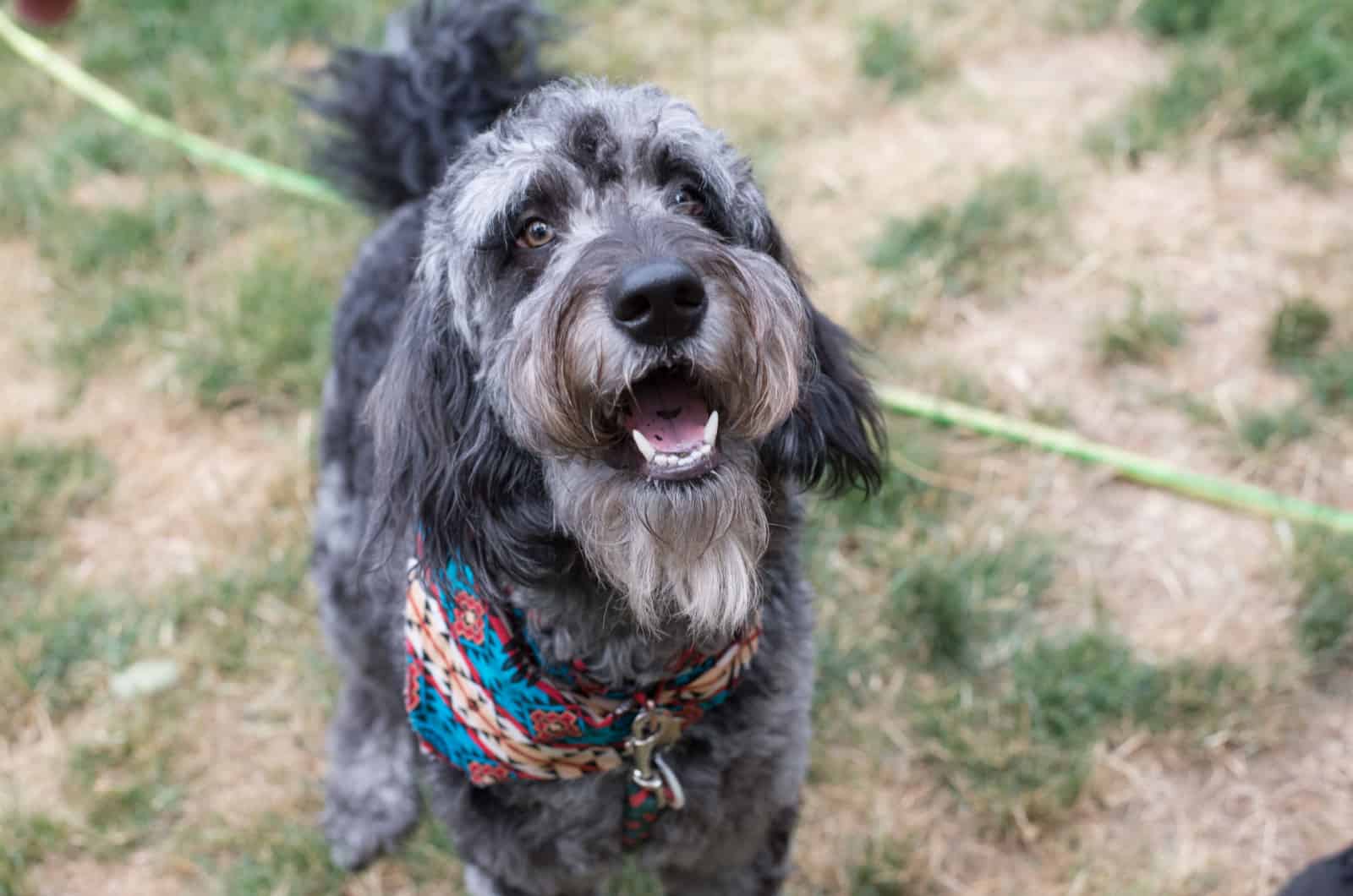Are you a fan of merle dogs like I am? Do you love Goldendoodle puppies? If you answered both questions with “yes” then it’s time to show you the beautiful merle Goldendoodle puppy.
Generally speaking, merle dogs have been around for quite some time.
We see these patterns in purebred dogs like Australian Shepherds, Catahoula Leopard Dogs, and Border Collies. But, what about designer dogs like Goldendoodles?
The merle Goldendoodle puppy is a rare sight, but once you see it you will instantly fall in love with it!
This article answers the most frequent questions about the merle Goldendoodle that dog lovers are curious about. We will also focus on debunking the myth about merle dogs being unhealthy.
What Is A Goldendoodle?
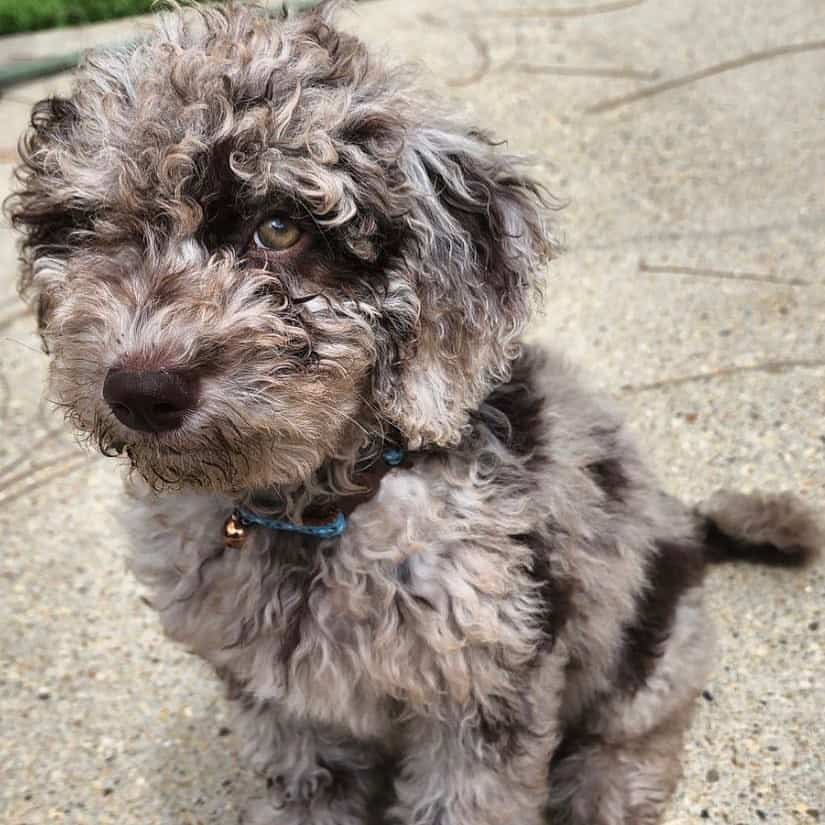
Photo from: @wispy_doodles
Before we explain what a merle Goldendoodle is, let’s quickly review what a Goldendoodle dog is! The Goldendoodle is a fun combination of a purebred Golden Retriever and a purebred standard Poodle.
To achieve mini Goldendoodles, breeders often cross purebred Golden Retrievers with miniature or toy Poodles. This means that the Goldendoodle puppy can come in three different sizes, depending on the Poodle parent: miniature, medium and standard Goldendoodle. The smallest of them all is the micro Goldendoodle. You can read more about the Goldendoodle’s growth and size in our Goldendoodle growth chart.
The Goldendoodle is a curly designer dog that became popular in the 90s — everyone wanted one!
Following its development, the Australian Goldendoodle also came to light. However, the Australian Goldendoodle does not derive from purebred parents. Instead, the Aussie Goldendoodle is a combination of two designer dogs: an Australian Labradoodle and an English Goldendoodle.
The story doesn’t end there, but we will keep it short and simple. Another thing that we want to mention is that there are different generations of Goldendoodle puppies, with F1 Goldendoodle being the most popular and desired designer dog.
What Color Is A Merle Goldendoodle?

Photo from: @thegoldendoodlebarn
Alright, bear with me! It’s quite difficult to put the merle Goldendoodle color in words, but we will try! The term “merle” refers to the coat color pattern. It is not a base color, nor is it a solid color.
Merle Goldendoodles have marble spots all over their coats. These spots can appear lighter or darker in color, but they are not the same as those we see in Dalmatians. These mottled spots lay on a solid or piebald Goldendoodle coat.
What makes the merle pattern unique is that no two merle Goldendoodles are the same. The merle pattern is as random as it can get! Splotches of the same color are randomly splashed over the whole Goldendoodle body: around the eyes, on ears, cheeks, shoulders, abdomen, limbs, and so on.
The merle Goldendoodle coat has an even, mottled appearance due to its solid base hue, which is typically reddish-brown or black, and its lighter blue-gray or reddish spots.
There are six types of merle coat colors in the Goldendoodle crossbreed:
1. Chocolate merle
2. Blue merle
3. Sable merle
4. Parti merle
5. Phantom merle
6. Red merle
So many merle patterns, right? Let’s give a brief description of each merle Goldendoodle coat pattern.
1. Chocolate Merle Goldendoodle
Chocolate merle Goldendoodles are pups with mottled coat patterns that are colored in dark brown.
The dark brown coat patterns can be located anywhere across the chocolate merle Goldendoodle body. There can also be several tan patterns across all four limbs and around the muzzle.
Chocolate merle Goldendoodles can inherit a wide white marking across their chest.
The chocolate merle gene also modifies the color of the Goldendoodle’s nose and paw pads. Having said that, chocolate merle Goldendoodles have brown noses, brown paw pads, and light to brown colored eyes.
2. Blue Merle Goldendoodle
The blue merle Goldendoodle is probably the rarest coat pattern out of all merle patterns that this crossbreed has to offer.
Remember when we mentioned Aussiedoodles? Well, it turns out that many people think that a blue merle Goldendoodle derives from breeding a red/blue merle Australian Shepherd or a merle Border Collie with a Poodle.
Doodle breeders frequently cross a light-colored Poodle with a blue merle Australian Shepherd to produce the blue merle coat. This means that we would be talking about a blue merle Aussiedoodle instead of a merle Goldendoodle.
So, we need a light-colored Poodle and a Golden Retriever to produce a blue merle Goldendoodle.
Due to the dominance of the blue merle hue, Goldendoodle puppies nearly always inherit a black or bluish base coat color.
The color combination of a blue merle Goldendoodle’s coat is composed of white, brown, and blue. Their coat is covered in random spots of these hues.
Blue merle Goldendoodles have pink or black colored noses and paw pads. Blue eyes are also one of the major physical features of blue merle Goldendoodles.
3. Sable Merle Goldendoodle
Sable merle Goldendoodles inherit a coat that may appear yellowish. In other words, the sable coat color of a Goldendoodle turns the hair from black (or red) to yellow. Sable color in Goldendoodles is caused by the ‘Pheomelanin’ pigment that derives from red or brown pigments.
The merle gene acts on a sable base color to produce the sable merle coat pattern in the Goldendoodle. Because there is less black pigment in a sable coat, there is less for the merle gene to act on, making the merle difficult to identify.
A percentage of the hairs in sable Goldendoodle puppies may have black or tips.
Sometimes there is just a “dusting” of black tips, but other times the dog appears almost completely black.
4. Parti Merle Goldendoodle
Parti colored Goldendoodle puppies are defined as a puppy with two colors. Add the merle pattern to it and you will get a parti merle Goldendoodle. About 30% or more of parti merle Goldendoodle bodies are colored in white.
The merle spots on a solid white colored coat of a parti merle Goldendoodle come in shades of black, gray, or ash. The majority of parti merle Goldendoodles inherit a black nose and dark colored eyes, but there are some that can inherit pink noses with a few dark spots on them.
To develop a parti merle Goldendoodle, breeders choose to cross a parti Poodle with a Golden Retriever.
5. Phantom Merle Goldendoodle
Phantom merle Goldendoodles inherit small patches of merle pattern around their eyebrows, chests, and legs. Sometimes, the merle patterns can be found underneath their tails.
Phantom merle Goldendoodles may not appear merle at all due to the fact that their merle patterns are not as prominent as they are in other merle Goldendoodles.
Most phantom merle Goldendoodles inherit black noses and dark brown eyes, but there are a few that inherit mesmerizing blue eyes.
Due to the fact that there is no such thing as a phantom Golden Retrievers, the phantom Poodle is the parent from which the phantom merle Goldendoodle gets its coat color.
6. Red Merle Goldendoodle
The red merle Goldendoodle is a red Goldendoodle whose merle patterns are more similar to liver or a chestnut brown color. As its name implies, the red merle Goldendoodle inherits reddish hairs that are best visible when exposed to sunlight.
The merle pattern in red Goldendoodles is described as different color patches combined with patches of solid color. The skin of red merle Goldendoodles is a bit lighter than in other merle Goldendoodles and it can also have several dark colored patches.
To achieve the red merle Goldendoodle look, a red Poodle should be introduced into the breeding program.
Depending on the gene interaction, red merle Goldendoodles can inherit either black or brown noses and paw pads. If you are not sure how a red merle dog looks like, take a look at the red merle Australian Shepherd dog that is the perfect example of this unique pattern.
What Is The Difference Between A Merle Goldendoodle And A Regular Goldendoodle?

Photo from: @roxythemerledoodle
The main (and perhaps only) difference between a merle Goldendoodle and a regular Goldendoodle is in coat color, of course!
Goldendoodles are known for their coat patterns. These coat patterns include: merle, parti, tri-color, tuxedo, and abstract.
The Goldendoodle has a wide genetic pool which means that it can inherit any of the Golden Retriever and Poodle colors. Popular Goldendoodle coat colors include: apricot, red, cream, black and white, café au lait, brindle, and parti.
The difference between a merle Goldendoodle and a regular Goldendoodle is in merle Goldendoodles being rarer. Other extremely rare colors include phantom, and black Goldendoodles.
Is Merle The Same As Brindle?
These two coat patterns are not as similar as you may think. Merle Goldendoodles have spots over their bodies, while brindle Goldendoodle have a distinct coat pattern that resembles tiger stripes.
Merle Goldendoodles come in different color variations, while brindle Goldendoodles inherit a red to chocolate base coat color with black “tiger stripes” on top.
Brindle Goldendoodle puppies are among the rarest of this designer dog breed.
Is Parti The Same As Merle?
No, it is not.
The parti Goldendoodle’s coat features a pattern of two solid colors all over it. The merle Goldendoodle on the other hand inherits both a merle pattern all over its coat and different color dilutions.
Parti and merle Goldendoodles differ slightly from one another. So, it is totally understandable why pet owners would mix these two Goldendoodle coat color variations.
What Is The Merle Gene?

Photo from: @kelly_mcdonald_photographs
So far we know that the merle coat color is a genetic trait that causes marble-like patches of different colors to occur across the Goldendoodle’s coat.
But, let me tell you that the Goldendoodle’s “merle” is not actually a coat color. Instead, it is a coat pattern that is regulated by the merle gene. The merle gene is labeled as a semi-dominant gene that can alter the color of any coat and comes in a variety of hues and patterns.
For example, a Goldendoodle can inherit a red, blue, sable, or chocolate base color, along with a merle gene. The merle gene produces unique merle patterns across the Goldendoodle’s base coat colors. In other words, the merle gene modifies the whole coat color with fun dots and spots.
But, the Goldendoodle’s coat color is not the only thing that is modified by the merle gene.
The merle gene is responsible for different colored eyes (heterochromia) in Goldendoodles, as well as different colored paw pads and nose pigmentation (pink, brown, black). Merle Goldendoodles’ color gene may regulate its eye color, making it a blue eyed dog. The merle gene also changes the Goldendoodle’s skin color.
Depending on how dominant the merle gene is, it can produce dilute merle patterns and harlequin coat color variations.
The harlequin coat pattern features a white base coat with a few big patches of dark pigmentation. While it is not seen in Goldendoodles, this merle variation is often seen in Great Danes. The diluted merle in Goldendoodle puppies features pale red or black coat colors with no patches at all.
While other parts of the coat have full pigmentation, the merle pattern is distinguished by irregularly shaped patches with diluted color. Goldendoodle puppies that express merle coat patterns produce eumelanin (black pigment), from which the merle pigmentation originates.
When Does A Goldendoodle Have A Merle Gene
The Goldendoodle acquires the merle gene from its merle Poodle parent.
Merle dogs can inherit this unique coat pattern from both parent merle parent dogs, making them “double merle” offspring. But in this case, the purebred Golden Retriever parent can never be a merle dog because the merle gene is not present in this dog breed.
This means that the merle Goldendoodle puppy can only derive from a purebred Poodle with merle genes. Sometimes, its Poodle parent may not have visible merle patterns on its coat, but it can still carry the recessive merle gene.
Even if the merle patches are tiny that they hardly resemble the merle pattern at all, they can nonetheless be passed onto the offspring.
Reputable Goldendoodle breeders know all too well how to produce merle Goldendoodle puppies and how to introduce the merle gene in their breeding program.
Do Merle Goldendoodle Puppies Change Color?
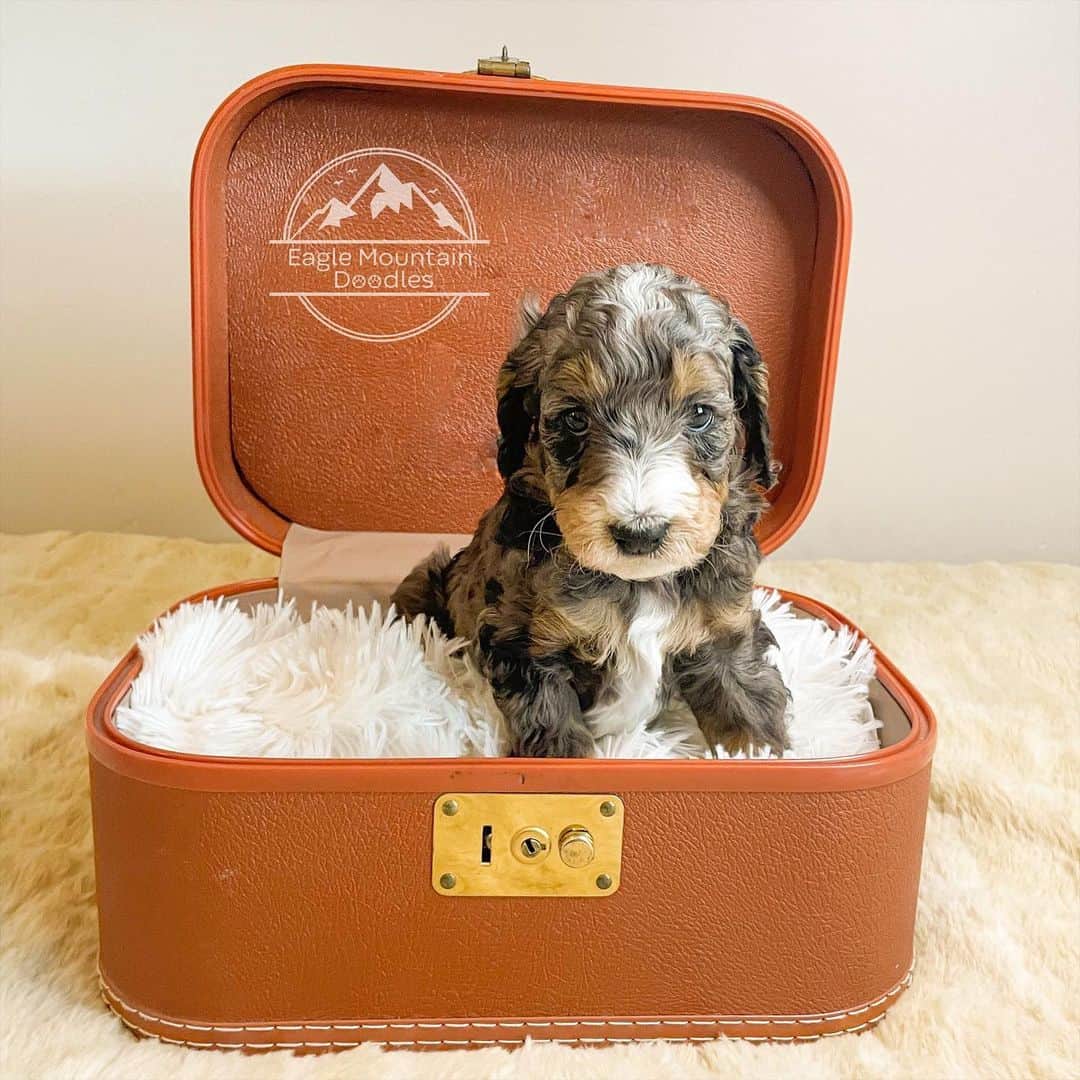
Photo from: @eaglemountaindoodles
Most merle puppies are typically born with white markings on their face and sometimes they cover their whole face. Butm merle Goldendoodle puppies are usually born with spots of black and tan.
Merle Goldendoodle puppies are born with a distinct merle pattern that tends to change over time. They can completely disappear as the merle Goldendoodle puppy grows.
As the merle Goldendoodle puppy grows older, the merle coat pattern along with a solid base color start to lighten.
Some pet owners say that their merle Goldendoodle’s coat pattern faded over time. Don’t get me wrong, the merle coat pattern in Goldendoodles does not completely disappear. Instead, the color simply turns paler than it was before.
Older merle Goldendoodle dogs even develop a few gray hairs here and there!
Change in coat color is also seen in merle Bernedoodles, merle Aussiedoodles, and other Doodle breeds.
Are Merle Goldendoodles Rare?
There are several reasons why merle Goldendoodles are thought to be rare pups.
First one being that merle Goldendoodles are rare because there are no merle Golden Retrievers that can be crossed with merle Poodles to increase the chance of merle Goldendoodle puppies in the litter.
Therefore, breeders choose merle Australian Shepherds or merle Border Collies to cross with Poodles to develop a merle puppy. But, then this merle puppy isn’t considered a merle Goldendoodle.
Another reason why merle Goldendoodles are rare is because it is thought that the merle gene causes blindness and deafness. This is usually the case when two merle dogs are bred (double merles).
What Is The Temperament Of A Merle Goldendoodle?
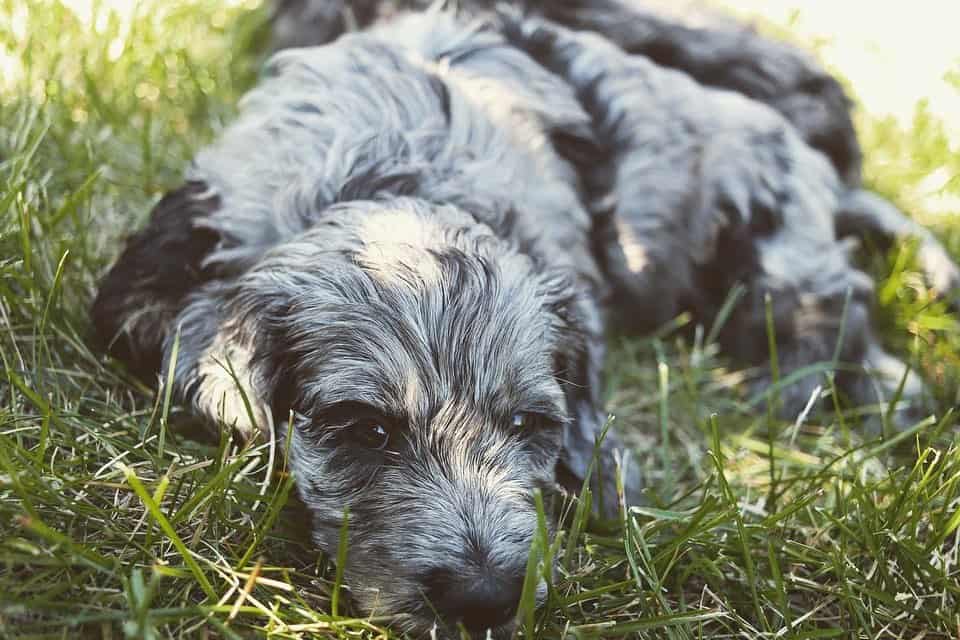
Photo from: @regencydoodles
If you are a fan of Doodle breeds, you are probably aware that these incredible designer dogs are extremely energetic dogs! Besides high-energy levels, merle Goldendoodles are affectionate pooches that love to spend time with their family.
They are very gentle dogs that get along well with children of all ages. This is why most merle Goldendoodle owners will tell you that this is the perfect family dog.
Merle Goldendoodles also like to hang out with other dogs and pets, so you don’t have to worry about leaving them together in the house while you’re gone.
Due to the fact that merle Goldendoodles originate from both extremely smart parent breeds, these designer dogs fall under the most intelligent dog breeds.
Are Merle Goldendoodles Healthy?
The debate on merle dogs being healthy is always a hot topic among pet owners. Despite merle dogs being labeled as unhealthy, merle Goldendoodles are generally healthy designer dogs.
Ethical Goldendoodle breeders that produce merles make sure that these pups get the best start possible. They put a lot of thought and effort into their Goldendoodle breeding programs to achieve healthy bloodlines.
After they sell their merle Goldendoodle puppies, the rest is on the owner. Responsible pet owners play a huge role in making their merle Goldendoodle puppies as healthy as possible.
This includes having their merle Goldendoodles regularly checked by the veterinarian, keeping up to date with shots and necessary deworming and flea treatments.
Keep in mind that congenital and developmental health issues can greatly affect the merle Goldendoodle’s lifespan.
Merle Goldendoodle Health Issues
Due to the fact that the real merle Goldendoodle puppy derives from a Golden Retriever and a Poodle, it may inherit any of the congenital health issues the two parent breeds. These health issues don’t necessarily have anything to do with the Goldendoodle being a merle puppy.
Having said that, merle Goldendoodle puppies have a high risk of developing the following health issues:
• Glaucoma
• Hip and elbow dysplasia
• Progressive retinal atrophy (PRA)
• Cataracts
• Deafness
Note that deafness and blindness in merle Goldendoodle puppies is relatively rare. These health issues are known to occur when two merle dogs are crossed.
Are Merle Goldendoodles Hypoallergenic?
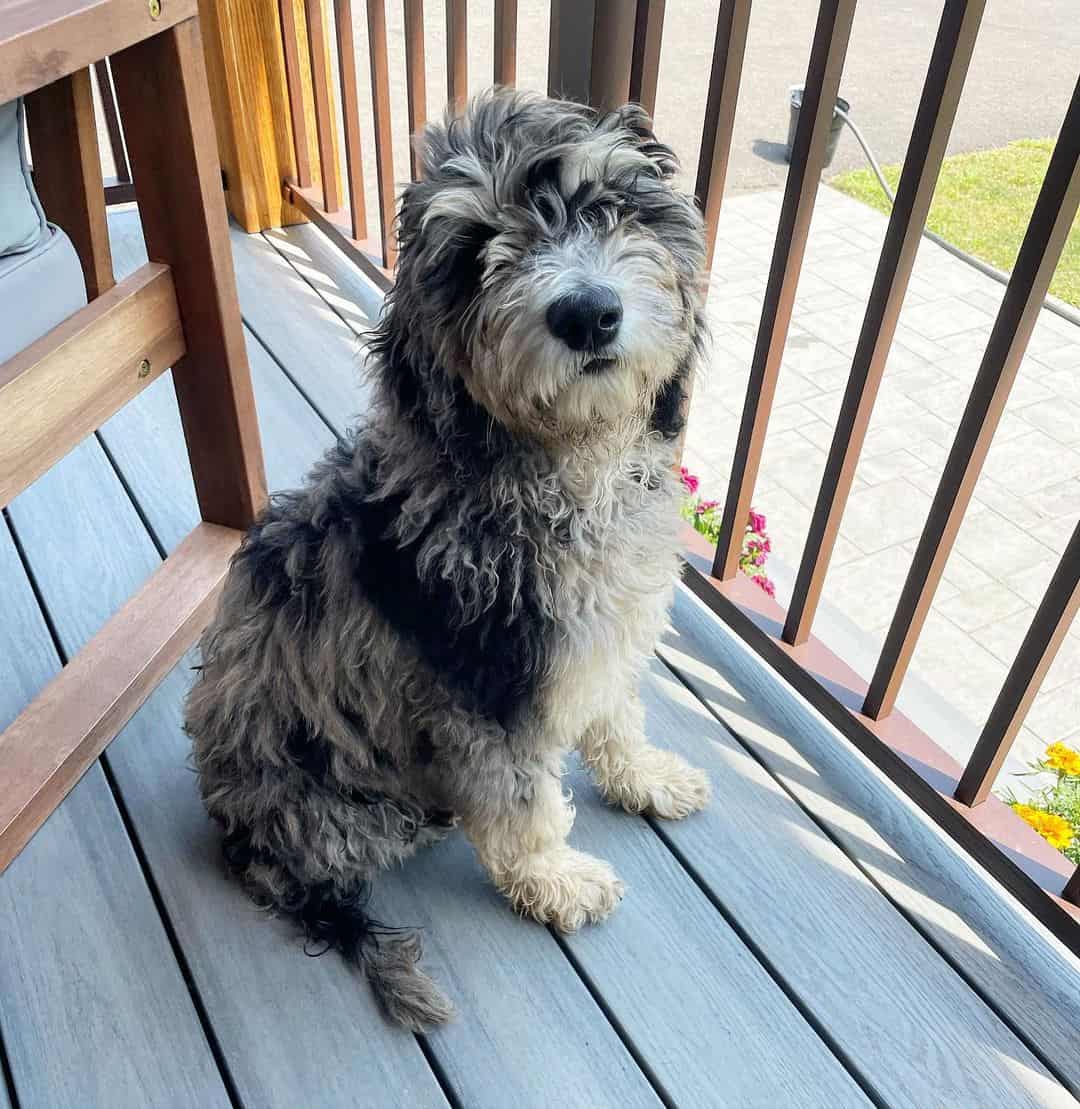
Photo from: @roxythemerledoodle
For the most part – yes!
Due to the fact that its parent is a hypoallergenic Poodle, the merle Goldendoodle can inherit this trait. However, merle Goldendoodle’s hypoallergenic traits will depend on its generation.
First-generation (f1) Goldendoodles have a 50:50 chance of being hypoallergenic, while the F1B Goldendoodle with more Poodle genes has a higher chance of being hypoallergenic.
How Much Is A Merle Goldendoodle?
Did you know that most breeders put higher price tags on merle Goldendoodle puppies? I am not sure why, but I am guessing that it has to do with merle Goldendoodles being a rare sight. However, I don’t think that is a good reason for these designer dogs to be expensive.
Merle Goldendoodle’s price in the United States ranges from $2000 to a whopping $8000, depending on what kind of merle pattern the Goldendoodle has.
Its price also depends on your location, breeding program, pedigree of the purebred Poodle parent and the purebred Golden Retriever parent, as well as on the competence of the Goldendoodle breeder.
Parti merle and phantom merle Goldendoodle puppies may cost as low as $2400 and as high as $3000. On the other hand, blue merle Goldendoodles are more expensive, with their price ranging between $3,000 and $3,500.
If a merle Goldendoodle is a miniature, then its price can go up to $4000.
Is The Merle Goldendoodle Recognized By AKC?
Let’s start by saying that the American Kennel Club (AKC) does not recognize mixed breed dogs, so it does not recognize the Goldendoodle crossbreed.
Having said that, the merle Goldendoodle can not be found within the American Kennel Club’s registry.
However, its parent, the purebred merle Poodle can be registered with the AKC, even though the merle color is not described in the official Poodle breed standard.
What Are The Pros And Cons Of Owning A Merle Goldendoodle?
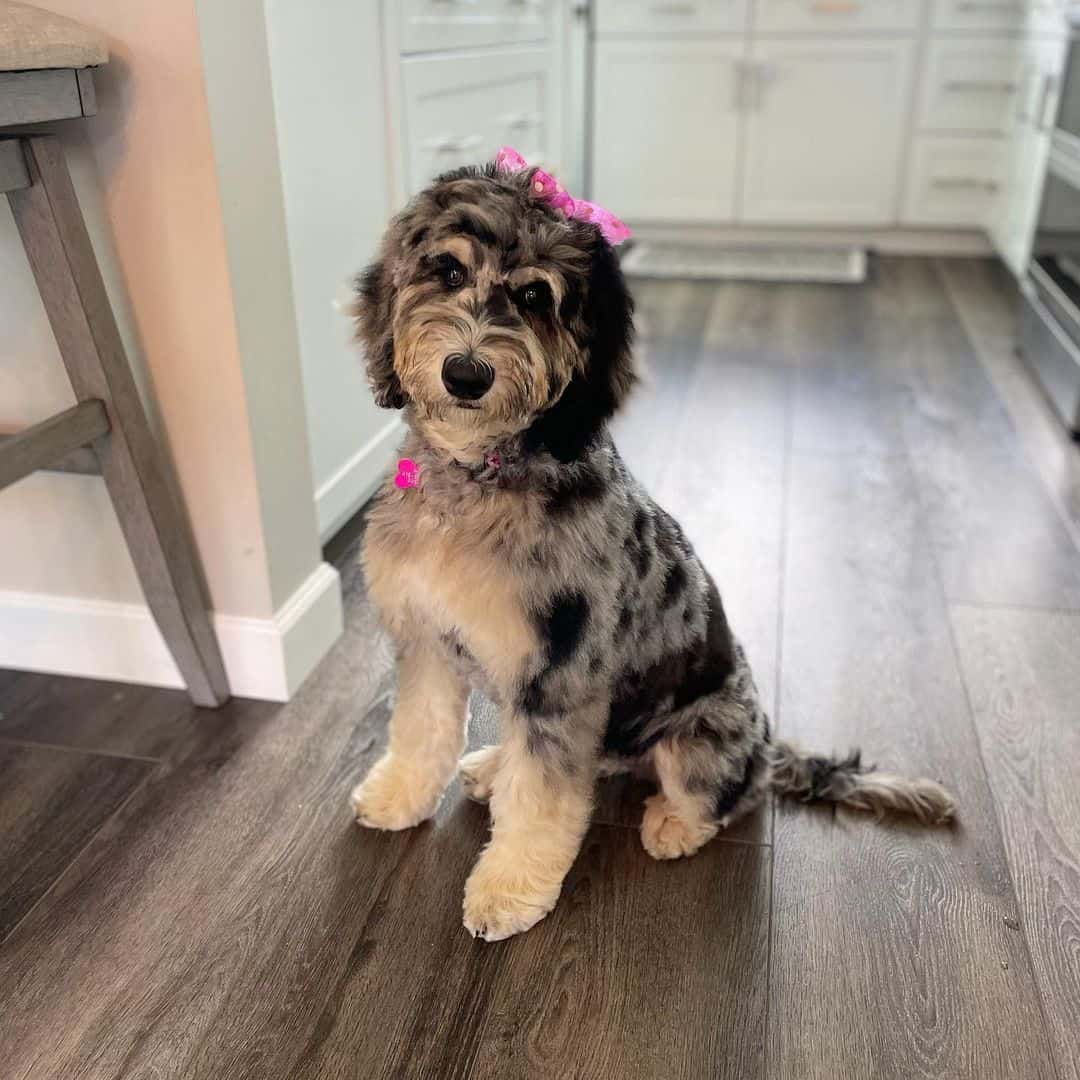
Photo from: @roxythemerledoodle
So far we have mostly mentioned the good sides of the merle Goldendoodle puppy. While they surely outweigh the bad ones, merle Goldendoodles might have some traits that aspiring pet owners may find undesirable.
To help you figure out if the merle Goldendoodle puppy is for you, we’re showing you the pros and cons of owning one. Let’s start with the good parts.
Pros Of Owning A Merle Goldendoodle
• Merle Goldendoodles are hypoallergenic puppies that are suitable pets for dog lovers who have troubles with dog allergies!
• In addition to being hypoallergenic, merle Goldendoodles are low-shedding dogs that won’t blow their coats seasonally. You don’t have to worry about excess fur all over the place!
• There are three different sizes of merle Goldendoodle puppies to choose from! If you live in a smaller apartment, I recommend you search for a mini merle Goldendoodle puppy.
• Merle Goldendoodles are the best cuddle buddies. These soft teddy bear-like pooches love to snuggle next to their owners. Besides keeping you warm, merle Goldendoodles make you feel loved and snug!
• Merle Goldendoodles are extremely fond of adventurous outings and love to go swimming! Trust me, you have never seen a better canine swimmer than a merle Goldendoodle!
• Even though merle Goldendoodles are not recognized by the AKC, they can still participate in dog shows organized by other kennel clubs. These include agility and obedience events.
Cons Of Owning A Merle Goldendoodle
• If left alone for extended periods of time, the merle Goldendoodle puppy can develop separation anxiety that can turn to boredom or aggressive behavior.
• Merle Goldendoodles are at risk of inheriting congenital health issues such as hip dysplasia, deafness, and eye problems that can lead to blindness.
• Even though they are considered hypoallergenic, merle Goldendoodles can still trigger allergies in some pet owners. There is no guarantee that the merle Goldendoodle is going to be a 100% hypoallergenic dog (there is no such thing).
• Merle Goldendoodles are lively dogs that need a lot of exercise and frequent walks. Aspiring pet owners that do not have the time to dedicate themselves completely to the merle Goldendoodle should skip on this breed.
• Merle Goldendoodles can be quite loud. Although this crossbreed is considered as quiet, untrained and unsocialized merle Goldendoodles can excessively bark on everyone and everything. It’s important to introduce training and early socialization.
• Due to the merle coat pattern being rare, merle Goldendoodles can get quite expensive. In some regions, the price of a merle Goldendoodle can reach a whopping $8000.
Let’s Wrap It Up
The merle Goldendoodle is truly a sight to behold. If you happen to see one in public, you might as well consider it a sign of good fortune!
Yes, the merle Goldendoodle is pretty rare, but there is still a chance that you could stumble upon one.
If you are an aspiring merle Goldendoodle owner, you will want to search for best Goldendoodle breeders in the U.S. that can provide you with a wonderful merle Goldendoodle puppy.
Remember that merle is only a coat pattern and you shouldn’t adopt or purchase a Goldendoodle simply because of its coat color.
The merle Goldendoodle is so much more than its merle coat color pattern!
Related Content
Red Merle Australian Shepherd – All About Their Amazing Nature
